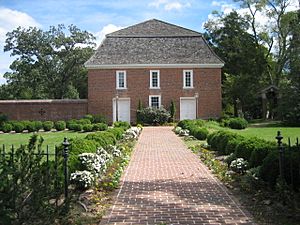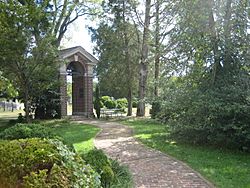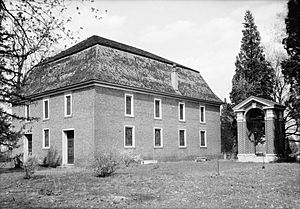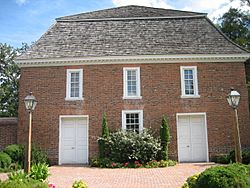St. Barnabas' Episcopal Church, Leeland facts for kids
Quick facts for kids New Brick ChurchSt. Barnabas Church |
|
|---|---|
 |
|
| Religion | |
| Affiliation | Episcopal |
| Location | |
| Location | 14705 Oak Grove Road Upper Marlboro, Maryland |
| Architecture | |
| Architect(s) | Christopher Lowndes, Walter Macomber |
| Architectural style | Georgian Colonial |
| Date established | 1705 |
| Groundbreaking | 1772 |
| Specifications | |
| Direction of façade | west |
| Length | 60 feet |
| Width | 46 feet |
| Materials | brick, wood shingle roof |
| Website | |
| http://www.stbarnabas.net | |
St. Barnabas Church, also known as St. Barnabas' Episcopal Church, Leeland, is a historic church in Leeland, Maryland. It was started in 1704 as the main church for Queen Anne Parish. This area was very rich in tobacco during the time of Colonial America. Because of this, the church became a key place for culture in southern Maryland. It played a role through important times like the American Revolution, the Civil War, and the Reconstruction. The church also has some very important art. It was even the site of a tense moment during the American Revolution, almost leading to a fight.
The church is located in the Brock Hall area of Prince George's County, Maryland. It uses an Upper Marlboro postal address.
Contents
History of St. Barnabas Church
On December 19, 1704, a church area called St. Paul's Parish was divided. This was done by the Maryland General Assembly. St. Paul's Parish was one of the 30 original church areas of the Anglican Church in the Province of Maryland. The northern part of St. Paul's Parish became Queen Anne Parish. The southern part remained St. Paul's.
The division meant that a small log chapel in the northeast part of St. Paul's Parish became a full church for the growing number of people. This was the first St. Barnabas church.
Soon after, in 1706, the government of Colonial Maryland allowed new towns to be planned nearby. These were "Queen Anne Town and Marlborough Town." This brought more growth to the area. In 1708, Reverend Jonathan White became the leader, or Rector, of Queen Anne Parish.
The Old Brick Church
Col. Henry Ridgley was a very important land-owner in the area. He was one of the first leaders of the church. In 1709, he promised £10 to help build a brick church. When he died in 1710, he left another £20 for the church.
The small log church was replaced in 1710 by the first brick church. This was the second St. Barnabas Church on the same land. It was quite small and is now called the Old Brick Church.
Reverend White stayed at St. Barnabas until 1717.
Henderson's Chapel and Holy Trinity
In 1713, Col. Ridgley's widow, Mary, built a chapel on her own land. On December 17, 1717, Reverend Jacob Henderson became the new Rector of Queen Anne Parish. He gained a lot of land when he married Mary Ridgley. In 1737, Henderson gave 4 acres of land for Queen Anne's Parish. This land had a chapel on it. That chapel was built for people in the northern part of the parish and was known as Henderson's Chapel. About 100 years later, in 1836, Henderson's Chapel became its own church called Holy Trinity Episcopal Church.
Henderson served St. Barnabas for 34 years and passed away on August 27, 1751.
A New Brick Church is Built
The St. Barnabas church area was in a very rich tobacco-growing part of Colonial Maryland. This made being the Rector of this church a very desired job. In 1771, Jonathan Boucher became the Rector of St. Barnabas.
Many important people visited the church during this time. George Washington and his family visited on October 4, 1772. The Royal Governor of Maryland, Robert Eden, also visited.
By 1772, the church had too many people for the old building. So, they asked Christopher Lowndes to build a new brick church. It was to be built near the old one. The new church would be 60 feet long and 46 feet wide.
The new church is a two-story building made of brick. It has a special brick pattern called Flemish bond. The main entrance has double doors. The windows on the first floor are taller than those on the second floor. The roof is covered with wood shingles. A special date, "AD July 3, 1774," is carved into one of the bricks on the east side.
Revolutionary Times
Jonathan Boucher, the Rector, was a strong supporter of the British King. He was called a Tory. He spoke against the American Revolution from the church pulpit. For months, he even preached with two loaded pistols next to him! In 1775, during his last sermon at St. Barnabas, he told a large, angry crowd that "no power on earth should prevent him from praying and shouting God Save the King." After his sermon, he grabbed the leader of the crowd, Osborn Sprigg, and walked with him to his horse, holding a pistol. Both men left safely. Boucher then went to England.
The 1800s
In the 1850s, the church was updated. It was changed to the Victorian style. New stained glass windows were put in, replacing the clear glass windows that were there originally.
Recent Times
In 1971, the "new Brick Church" needed repairs. It was carefully restored to look like it did when it was first built by Lowndes. This included putting back clear windows. A new chapel was also added. Architect Walter Macomber led this work. The restored church was officially opened in October 1974.
As of 2015[update] St. Barnabas Church is still an active church. It is part of the Episcopal Diocese of Washington. Since January 15, 2015, the Rector has been the Rev. Robyn E Franklin-Vaughn.
Queen Anne School
Between 1955 and 1976, many private schools were started in the southern United States. Queen Anne School was one of them, founded at St. Barnabas' Church. It was a private school for both boys and girls, from grades 7 to 12. It was located on a 50-acre campus next to the new Brick Church. The school was an independent learning place. It closed after the 2010-2011 school year. The 50-acre campus was then rented out and used by Imagine Schools.
Belt Woods
Belt Woods When W. Seton Belt passed away in 1959, he left a large amount of money and land to the church. He had been the treasurer of St. Barnabas. This included 3,200 acres across six farms, including Belt Woods. He said that the other farms should be sold to help the church. But he also said that "the trees on his home farm should never be cut down and his 624-acre home farm never sold." In 1976, the church leaders asked the court to change this rule. They were allowed to sell and cut down trees on the farm.
The oak trees in the "North Woods" were cut down in 1981 by a company from New Jersey. They harvested 563 old oak and tulip trees for wood veneer. In 1994, the trust sold 109 acres with the oldest trees to the state of Maryland. This land became a nature preserve and was sold for $628,000.
Art in the Church
The church is home to The Last Supper painting by Gustavus Hesselius. This painting was ordered in October 1721. It was the first public art project ever recorded in the American colonies. Before this, most paintings in the new world were portraits of people. The Last Supper was the first important American painting to show a scene with many figures.
The painting is 35 inches tall and 117 1/2 inches wide. It was first made for the first Brick Church. It stayed there until the current church was built. The painting disappeared during the building of the new church. It was found again in a private collection either in 1848 or 1914.
The painting was loaned to places like the Philadelphia Museum of Art and the American Swedish Historical Museum. It was also shown at an exhibition in Brooklyn in 1917.
The painting was given back to St. Barnabas Church in a will after Rose Neel Warrington passed away.




